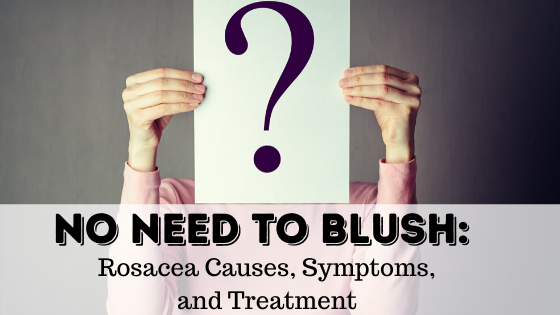
Nobody likes to talk about rashes, but when the breakout affects your face it’s hard to hide. Rosacea, a skin condition that involves red, pus-filled bumps on the face, can strike at any age, but it’s more common to affect light-skinned women over the age of 30. Because the condition is usually limited to the face, it can affect a person’s self-confidence, lead to embarrassment, isolation, and depression.
How does Rosacea start?
Rosacea often begins with easy flushing or blushing of the face before bumps appear. The condition includes three subtypes, each with a unique set of symptoms. Although no one knows the exact cause of rosacea, patients who have a family history of it are at a higher risk. Some doctors believe environmental factors like the following could contribute to a flare:
- eating spicy foods
- eating items that contain the compound cinnamaldehyde, such as cinnamon, chocolate, tomatoes, and citrus
- drinking hot coffee or tea
- having the intestinal bacteria Helicobacter pylori
- a skin mite called demodex and the bacterium it carries, Bacillus oleronius
- the presence of cathelicidin (a protein that protects the skin from infection)
Types of Rosacea
Sub-type1
Includes facial redness and blushing on the forehead, nose, cheeks and chin
Visibly broken blood vessels
Skin may be sensitive and swollen or it may itch and burn
Dry, rough or scaly skin
Sub-type 2
Acne-like breakouts that tend to come and go
Oily skin
Sensitive skin that may burn and sting
Visibly broken blood vessels
Raised patches of skin
Sub-type 3
A person usually exhibits symptoms of one of the other sub-types before this sub-type appears. It’s rare and happens more often in men than in women.
Skin takes on a bumpy texture
Skin thickens most commonly on the nose but may also thicken on forehead and cheeks
Oily skin
Pores look large
Visibly broken blood vessels
Sub-type 4
Rosacea can affect the eyes. When it does a person will have one or more of these symptoms:
Eyes feel gritty, burn or sting, may be very dry or itch
Eyes are sensitive to light
Visibly broken blood vessel in eye
Cysts form on the eyelid
Vision impairment
Why should I seek treatment?
Untreated rosacea can lead to permanent redness and other skin changes. Your doctor or dermatologist can help you reduce and clear the signs of a flare-up and reduce the chances you’ll experience another flare. You’ll probably talk about triggers that cause your rosacea to become worse and how to protect your skin from sun damage which can make rosacea worse.
If you’ve noticed any of the above symptoms, it’s time to schedule an appointment with your primary care provider or a dermatologist. And if you want to learn more about rosacea, the American Academy of Dermatology has a great section dedicated just to this issue.



Speak Your Mind